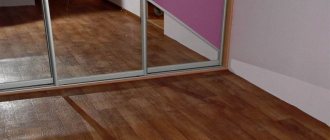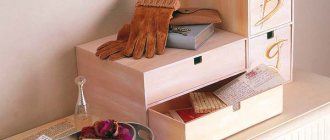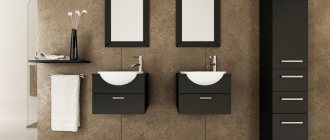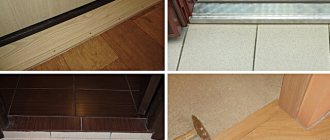Design of a small, bright bathroom with efficient use of space
Nowadays, small-sized studio apartments, or apartments in the so-called “Khrushchev” buildings, are very popular, where every centimeter must be used correctly in order to get the maximum benefit from the space. For a modern interior, beautiful, high-quality and functional furniture is the main rule.
A cabinet for a washing machine in the bathroom allows you to close the machine and use the rest of the space for storing household chemicals, towels, and linen.
One of the important points is the equipment of the place for the washing machine. It doesn’t matter where it will be - in the bathroom, hallway or kitchen. Installation in the bathroom is of course much simpler than, for example, in the kitchen. No additional hosing is required for installation.
Cabinet for washing machine in the bathroom in a built-in niche
To save space in a room or disguise household appliances, it has become popular to build a cabinet above the washing machine.
A built-in cabinet for a washing machine in a small bathroom allows you to properly use the free space
Washer and dryer in a cabinet with convenient and functional shelves and drawers
Let's start with the positives.
The cabinet for the boiler above the washing machine protects it well from prying eyes and serves as additional storage space
A built-in wardrobe can only be installed in large rooms. It requires quite a lot of space, so this option, unfortunately, is not suitable for small apartments.
Rack with open shelves above the washing machine in a small bathroom
The only downside is that you may not notice the leak in time if the washing machine is installed inside. Also, the cabinet may not last long, but this will depend on the material you choose for its manufacture.
White homemade cabinet above the washing machine installed in a niche
Minimalist bathroom with washing machine placed under the cabinet
Selection of building materials
Cabinet above the washing machine made of white semi-gloss laminated chipboard, made independently
Before choosing building materials, you need to carefully and accurately measure the bathroom and washing machine. Different models have different dimensions. Then you need to make a drawing, taking into account the dimensions of the cabinet. It should be 3-4 cm wider than the washing machine.
A small wall cabinet above the washing machine in a niche
In terms of height, choose the option that is most suitable for you, it can vary from 2 to 2.5 meters. The higher the structure, the greater the number of functional shelves. Please note: the tall structure is unstable. The size of the cabinet should correspond to the size of the bathroom; large furniture in small rooms looks awkward and takes up a lot of space.
Moisture-resistant MDF for making a bathroom cabinet
After taking measurements, we go to the store and select moisture-resistant MDF, which is the most suitable and budget option for making furniture. This is a relatively new material, which is obtained by pressing fine dry sawdust. But at the same time, it is very resistant to aggressive environmental influences. When choosing MDF, you should pay attention to the thickness, choose the required color and texture. It must have a PVC coating for additional protection from moisture. The MDF thickness required is at least 19-20 mm; with such parameters, the cabinet will be very reliable and can withstand a washing machine, the weight of which is about 80 kg.
Carefully examine the surface of the product for chips and scratches. Start making.
Equipment and tools for cabinet making
You will need a fairly standard set of tools:
- drill;
- screwdriver;
- jigsaw;
- metal corners;
- screws;
- tape measure, pencil.
Before making the cabinet, we calculate the dimensions of all parts. The intermediate shelves will be 10-15 mm shorter than the bottom and top walls. We make markings and cut out parts to individual sizes. You can order ready-made material, which will be cut on a special machine.
Details of the future shelf made of white MDF
Step-by-step instruction:
A cabinet with a machine inside and shelves, built into a bathroom niche
In some cases, the washing machine is not closed with a door, and it “fits” harmoniously into the new interior. A white washing machine can be placed in a classic snow-white bathroom, and a gray metallic one will suit a bathroom with gray ceramic tiles.
Large cabinet above the washing machine near the shower
If there is no time and opportunity to place a cabinet, a simpler and more affordable option is possible - placing shelves above the washing machine. They can also store various accessories that are necessary for daily care.
Convenient shelves above the washing machine
They can be made from available materials, for example, pieces of MDF that could have been left over after renovating an apartment, or from glass coated with film (for easier maintenance).
Spacious, hand-made closed bathroom cabinet
Bathroom cabinet with space for a washing machine
Should I buy ready-made furniture, or create a budget-friendly and most suitable universal rack or cabinet? In any case, the choice is yours.
Corner cabinet with built-in washing machine
Washing machine in a small bathroom with convenient and functional cabinets and shelves
Photo selection of cabinets for a washing machine in the interior:
Where to install a washing machine in a small apartment is a question that each owner decides in his own way. Such equipment seems to be located in the bathroom. But due to the small area of this room, it is not always possible to find a place for a suitable washing machine here.
Therefore, quite often the washing machine is placed in the kitchen, installing it next to the sink. There is also good access to water supply and drainage pipes. But the presence of a washing machine in the kitchen still, firstly, reduces the useful volume of the kitchen space (a table that is more necessary in the kitchen could be located here), and secondly, and this is perhaps the most important thing, the constant fuss with linen and washing powder is a very unattractive activity that does not go well with cooking. And from a hygiene point of view, this is not advisable.
On the other hand, in most apartments, both one-room and two-room in old houses, you can easily install a washing machine in the hallway. It is quite possible that someone in this place has a built-in wardrobe (I know this from my own experience). So it’s worth getting rid of this closet, and for outerwear a small hanger is enough (that’s exactly what we did). You can, of course, embed a washing machine into this built-in cabinet, but it seemed to me that this option is less aesthetically pleasing.
The decision has been made - we install a washing machine in the hallway. You just need to connect it to the water supply, sewerage and electrical networks. All the elements necessary to connect the washing machine are included in its kit, but they are short in length.
To connect to the electrical network, given the rather large power of the heating elements of the washing machine, you should lay a separate cable from the distribution board and connect it through an RCD (residual current device). In this case, the outlet should be located next to the machine to prevent the use of an extension cord. In addition, it must be the same type as the plug and designed for the maximum power consumption of the machine.
But the main question is how to connect the water supply and drain hoses to the washing machine. Since one of the walls of the hallway where the washing machine will be installed is adjacent to the bathroom, these hoses must be passed through a hole made in this wall. And in the bathroom you can always find a way to install and connect them.
Having chosen the connection points for the drain and water hoses, we determine their required length. It should be taken into account that the hoses must have some reserve, allowing the washing machine to move slightly. In addition, the drain hose of some washing machines requires an additional reserve, since its top point should be located at a height of about 60 cm to prevent spontaneous drainage of water. Again, the drain hose may be permanently connected to the machine at the factory (and only replaced when it fails) and if it is not the required length, the hose must be extended. This can be easily done using a connecting pipe.
It is better to purchase a water hose (eyeliner) not only of the required length, but of good quality. You should not skimp on it, because if it is damaged, you can flood the neighbors below.
Having prepared the hoses of the required length, we pass them into the bathroom through the hole in the wall. As for the eyeliner, it is advisable to protect its free end from dust and grains of sand when performing this operation.
Having extended the hoses into the bathroom, we begin to connect them with our own hands to the water supply and sewer pipes. The liner can be connected to the water supply at the faucet connection point under the washbasin. To perform this work, it is better to remove the siphon to provide free access to the pipes. In addition, it will still need to be replaced with a siphon of a different design, which has a special pipe for connecting the drain hose.
In old houses, pipe distribution is usually done along the surface of the walls, and one mixer is installed on the bathtub and washbasin (as in the case under consideration). Therefore, you must first install a tee at the place where the pipes are connected with a coupling (and such a connection must be present), and at the outlet of which put a shut-off valve specially designed for connecting a washing machine. We screw the connection nut with a rubber gasket onto the tap pipe, which has an external thread.
After this, we put the end of the drain hose onto the sink siphon pipe and clamp it with a plumbing clamp. Having connected the drain hose, we assemble the sink siphon.
After checking all connections, we install the washing machine in place. After this, it is necessary to level the position of the washing machine using its adjustable front legs so that it stands stable and the top cover of the body is horizontal. Correct installation of the machine is the key to its good performance.
Proper placement of the washing machine in the hallway or hallway
It is clear that the most convenient place to install a washing machine is the bathroom. But due to the small area of this room, we have to look for other options. Placing it in a hallway, or even in a hallway closet, is sometimes the only option.
This is especially true for Soviet “Khrushchev” buildings. But you need to weigh all the pros and cons before making such a decision.
Installing a washing machine in the hallway is quite possible. You just need to take into account the area of the room and make sure that the machine will not interfere with opening the front door.
Also note the following:
- distance from communications.
A niche will help save room space. But, of course, it will be easier to fit a narrow washing machine into a small hallway.
Closet
If there is a niche in one of the walls of the corridor, you can install a wardrobe with sliding, hinged or folding doors in it. In this way, you can not only hide equipment, but also create additional shelves for storing washing supplies and other things.
Cabinets are made floor-mounted or wall-mounted. Such pieces of furniture may look like narrow pencil cases or cabinets.
Some wardrobes are a whole system of modules for detergents, dirty laundry and even an automatic dryer. Therefore, such a cabinet serves as a full-fledged mini-laundry room.
Materials for making furniture:
The shape of the cabinets can be either straight or corner.
Are you unplugging your washing machine?
Oh yes! No
Door
You can hide the washing machine in the hallway by installing a sliding door. This design will be perceived as a wardrobe. And behind the doors you can also organize a place to store various useful items.
Corner
If the presence of a washing machine in the hallway does not bother you and you do not want to disguise it, you can simply place the equipment in a suitable corner. This setup has its advantages:
- The device is more convenient to use due to free access.
- The detergent tray, drum and machine door will be well ventilated and dry, which will prevent the appearance of mold and unpleasant odors.
Curtain
Instead of a door, you can use various curtains. To do this, you need to secure the cornice and choose a textile option that matches the interior of the hallway. Modern thread curtains made of different materials will fit harmoniously and successfully delimit the space.
Do you store laundry in the washing machine?
Oh yes! No.
Drain
Try to choose a place for the washing machine as close as possible to the water supply and sewage system. If the distance to communications is large, you will have to buy new long hoses. It is not advisable to make connections from short ones, because this will increase the risk of water leakage.
The drain hose of the equipment must exit at a certain angle to avoid stagnation of water and unpleasant odor. Too long (more than 3 m) may increase the load on the pump and lead to damage to the machine.
Connection to the sewer can be avoided by directing the drain hose into the bathtub or toilet using the special hook in the shape of the letter “U” supplied with the washing machine.
Water supply
You can connect the machine to the water supply in the following ways:
- It is connected to a pipe made of metal using a coupling. It is attached to the pipe, having previously drilled the required hole. Then screw on a ball valve with a 3/4 threaded outlet, to which the hose is connected.
- A fitting is used for a metal-plastic pipe. The insertion site is treated with sealant. A tap is placed on the fitting, and then a hose is connected.
- If there is a water outlet in the wall, the machine is connected to it directly through a tap.
If there is no electrical outlet in the hallway, you need to install it in close proximity to the washing machine. It is highly undesirable to use an extension cord in this case. Be aware of the risk of malfunction and water leakage.
When you decide to place the machine in the hallway, think about how to hide the hoses to maintain the aesthetic appearance of the room. This is easy to do if the washing machine and the bathroom are separated by a wall. In this case, you just need to hollow out a hole in it at the desired level. And if the car is far from the bathroom, you will have to hide all communications in the floor.
With this arrangement, appearance matters. It should not spoil the design of the room.
Remember that washing equipment cannot be installed in living rooms. In the event of a breakdown and leak, not a single insurance company will agree to compensate for the damage to the neighbors whom you flooded. Experts will consider that the culprit deliberately created a dangerous situation by placing it in an inappropriate place.
You can install a washing machine in the hallway. At the same time, it is important to think through all the details and ensure that the device is properly connected to the necessary communications. And so that guests do not end up in the laundry room at the entrance to the apartment, the equipment can be disguised using an interesting interior solution: a cabinet, door or curtain.
PreviousNext
Source: https://remontcma.ru/stiralnaya-mashina/ekspluatatsiya/gramotnoe-razmeshchenie-koridore-ili-prihozhej/
How to install a washing machine in the hallway yourself - step-by-step instructions
- We punch a small hole in the partition so that the hoses from the washing machine, when installing it in place, fit into it without bending, and from the side of the bathroom there should be no obstacles to their laying to the water pipe and drain.
- Due to the short length of the hoses included with the washing machine, they will have to be extended. To do this, you should purchase a liner of the required length and an additional hose to extend the drain hose.
- We extend the standard drain hose using a special plastic pipe. We clamp the ends of the hoses on the pipe with clamps.
- To prevent foreign particles of construction debris from getting into the liner, we protected its open hole by wrapping the end of the liner with plastic film.
- We screw a shut-off valve designed specifically for washing machines into the tee pre-installed in the water pipe.
- We pull the drain hose onto the sink siphon pipe and crimp it with a clamp.
- After making all the connections, we assemble the sink siphon.
A washing machine is a technique that a modern person can hardly live without; some people cannot even imagine their life without a washing machine. However, there are apartments in which you don’t know where to put a unit of impressive size; there is simply no room in either the kitchen or the bathroom. This is where the idea comes - to install the machine in the hallway. But is it possible to place it like this? Let's reason together.
Washing machine in the hallway - how to install and hide
A washing machine is a technique that a modern person can hardly live without; some people cannot even imagine their life without a washing machine. However, there are apartments in which you don’t know where to put a unit of impressive size; there is simply no room in either the kitchen or the bathroom. This is where the idea comes - to install the machine in the hallway. But is it possible to place it like this? Let's reason together.
What should you pay attention to?
Sometimes the corridor really becomes the last option where you can put the typewriter. Otherwise, you will have to do without it altogether or carry things to the laundry and dry cleaning all the time. Weekly washing of clothes in the laundry will become expensive, so you will have to put the machine in the hallway.
It is quite possible to install the machine in the corridor, but to do this you need to consider the following:
- the area of the corridor, whether there is any space in it, whether the car will interfere when entering the apartment or when opening the door to the room;
- how far the machine will be from the sewerage system and water supply;
Important! A drain hose that is too long will put stress on the pump, so it can quickly fail. - is there a niche in the corridor that can be used to install a typewriter, thereby hiding it;
- dimensions of the washing machine, the size of the machine is no less important than the size of the corridor; when the area is so limited, try to choose narrow models of machines;
- Don’t forget about the aesthetic side of the issue; a washing machine in the hallway is not entirely appropriate. A person entering an apartment will feel like they are in a mini-laundromat, so they need to hide the equipment somehow.
Connecting a washing machine
The nuances of connecting a washing machine in the hallway consist mainly of how to hide the hoses running from the machine to the drain and water supply. If the machine will stand through the wall with the bathroom, then in this case it will be easier to connect it and hide the communications. You can run the hoses through a hole in the wall.
It’s a completely different matter if the machine is on the opposite side of the bathroom. In this case, the hoses running across the entire corridor will obviously get in the way; you won’t want to trip over them every day. The only possible solution is to hide communications in the floor.
To connect the washing machine you need to buy a long drain and inlet hoses. Do not connect short hoses, this risks water leakage. As we have already noted, a long hose affects the operation of the drain pump. But in many ways everything will depend on the brand of washing machine. In most models it is not recommended to exceed the hose length by 3 m, while in Zanussi washing machines this figure is greater, since these machines have a more powerful drain motor.
For your information! As a last resort, you can extend the drain hose on any washing machine, but then do not count on warranty repairs if the equipment breaks down.
You can connect the drain of a washing machine installed in the hallway only through a siphon, or directly into the sewer. These methods have been described in detail by us more than once. As for connecting water to the machine, it can be done in three ways:
- using a release coupling if you are connecting to a metal pipe. To do this, the coupling is placed on the pipe, and a hole is made in the pipe for the flow of water. A ball valve with a ¾ threaded outlet for the inlet hose of the washing machine is connected to the coupling.
- using a fitting if you are connecting to a metal-plastic pipe. An insert is made into the water pipe and a fitting is connected. The fitting connection points must be carefully sealed and an elastic band must be installed. Next, we screw the tap onto the fitting, and the inlet hose from the washing machine to the tap.
- through a tee, such a connection is possible to the sink faucet in the bathroom. A tee with a tap is connected between the mixer hose and the water supply. And a machine is connected to the branch of the tee.
Another connection method is possible if there is a separate water supply outlet in the wall. The faucet and washing machine are directly connected to it.
In addition to the plumbing and water drainage, you also need to take care of the outlet. It is advisable that it be located closer to the technology. Otherwise, you will have to make such an outlet, which is described in detail in the article How to connect a washing machine to the mains.
How to hide equipment
All that remains is to talk about how to hide the equipment, how to install it so that no one sees the unit, and so that it does not interfere with anyone. Even in such a small room as a corridor or hallway, there are different ideas for the location of the machine.
In the photo below, the washing machine is hidden in a closet; it can be a cabinet under the washing machine, or a large pencil case with additional shelves on top for household chemicals.
Here is another option for placing the machine - behind sliding doors or in a closet. It’s very convenient, because you can make hangers for clothes or shelves for household chemicals and other things nearby.
If you still don’t want to hide the machine, it may look like the photo below. On the one hand, it is not aesthetically pleasing, but on the other hand, nothing prevents you from opening the drum and cuvette a little so that the machine is ventilated and no odors appear in it.
Some people hide the washing machine behind a curtain, for example, as shown in the photo below. Curtains are selected in accordance with the style of the room. You can hang them either on a rod fixed between the walls or on a ceiling cornice.
So, the washing machine is placed in the hallway, but very rarely. This option is chosen only if there is limited space in the kitchen or bathroom, or if communications are close to the corridor. Therefore, before installing your car like this, think carefully.
mashmaster.ru
What should you pay attention to?
Sometimes the corridor really becomes the last option where you can put the typewriter. Otherwise, you will have to do without it altogether or carry things to the laundry and dry cleaning all the time.
Weekly washing of clothes in the laundry will become expensive, so you will have to put the machine in the hallway.
It is quite possible to install the machine in the corridor, but to do this you need to consider the following:
- the area of the corridor, whether there is any space in it, whether the car will interfere when entering the apartment or when opening the door to the room;
- how far the machine will be from the sewerage system and water supply;
Important! A drain hose that is too long will put stress on the pump, so it can quickly fail.
- is there a niche in the corridor that can be used to install a typewriter, thereby hiding it;
- dimensions of the washing machine, the size of the machine is no less important than the size of the corridor; when the area is so limited, try to choose narrow models of machines;
- Don’t forget about the aesthetic side of the issue; a washing machine in the hallway is not entirely appropriate. A person entering an apartment will feel like they are in a mini-laundromat, so they need to hide the equipment somehow.
Connecting a washing machine
The nuances of connecting a washing machine in the hallway consist mainly of how to hide the hoses running from the machine to the drain and water supply. If the machine will stand through the wall with the bathroom, then in this case it will be easier to connect it and hide the communications. You can run the hoses through a hole in the wall.
It’s a completely different matter if the machine is on the opposite side of the bathroom. In this case, the hoses running across the entire corridor will obviously get in the way; you won’t want to trip over them every day. The only possible solution is to hide communications in the floor.
To connect the washing machine you need to buy a long drain and inlet hoses. Do not connect short hoses, this risks water leakage. As we have already noted, a long hose affects the operation of the drain pump. But in many ways everything will depend on the brand of washing machine. In most models it is not recommended to exceed the hose length by 3 m,
whereas in Zanussi washing machines, this figure is higher, since these machines have a more powerful drain motor.
For your information! As a last resort, you can extend the drain hose on any washing machine, but then do not count on warranty repairs if the equipment breaks down.
How to hide equipment
All that remains is to talk about how to hide the equipment, how to install it so that no one sees the unit, and so that it does not interfere with anyone. Even in such a small room as a corridor or hallway, there are different ideas for the location of the machine.
In the photo below, the washing machine is hidden in a closet; it can be a cabinet under the washing machine, or a large pencil case with additional shelves on top for household chemicals.
Here is another option for placing the machine - behind sliding doors or in a closet. It’s very convenient, because you can make hangers for clothes or shelves for household chemicals and other things nearby.
If you still don’t want to hide the machine, it may look like the photo below. On the one hand, it is not aesthetically pleasing, but on the other hand, nothing prevents you from opening the drum and cuvette a little so that the machine is ventilated and no odors appear in it.
Some people hide the washing machine behind a curtain, for example, as shown in the photo below. Curtains are selected in accordance with the style of the room. You can hang them either on a rod fixed between the walls or on a ceiling cornice.
So, the washing machine is placed in the hallway, but very rarely. This option is chosen only if there is limited space in the kitchen or bathroom, or if communications are close to the corridor. Therefore, before installing your car like this, think carefully.
It often happens that the size and layout of the kitchen do not allow installing a full-fledged refrigerator there. But the whole kitchen revolves around him! Yes, and you want the room to be beautiful, make a good impression, be comfortable and functional. What to do if the kitchen size is only 5 m2?
With this solution you can easily create a comfortable and functional interior.
Ways to place the refrigerator:
- If there is a small pantry next to the kitchen, the refrigerator can be placed there;
- Disguising the refrigerator as a cabinet in the hallway or corridor;
- Combining a kitchen with a loggia.
One of the most acceptable and less expensive options is to place a refrigerator in the hallway. Yes, at first it seems a little unusual, but over time you will see that it is convenient. In addition, the choice is small when you have to choose between appliances that should be placed in the kitchen: an oven or a refrigerator.
Ways to place a refrigerator in the hallway:
- In a special cabinet, which was made to order;
- In the corridor niche;
- In a small hallway closet.
Placing a refrigerator in a closet has a number of advantages: a significant amount of space is freed up in the kitchen, there is a lot of light, the built-in refrigerator will not disturb anyone. At the same time, the cabinet will continue to perform all its functions. You need to personally decide what kind of cabinet design you want to see in your home.
How to fit into the interior
SMA may look strange in the hallway and not fit with the design solution. To avoid this, hide the equipment in a closet, cabinet or behind closet doors. Then the useful space on the car and above it will be used, and the equipment will not spoil the appearance of the corridor. Hang shelves above the machine and stock them with laundry detergents and household chemicals. If space allows, install (hang) a drying cabinet.
Options with curtains and blinds are available. When using them, it is important to conveniently secure the cornice, as well as choose the material to match the tone of the entire room.
It often happens that the size and layout of the kitchen do not allow installing a full-fledged refrigerator there. But the whole kitchen revolves around him! Yes, and you want the room to be beautiful, make a good impression, be comfortable and functional. What to do if the kitchen size is only 5 m2?
With this solution you can easily create a comfortable and functional interior.
Ways to place the refrigerator:
- If there is a small pantry next to the kitchen, the refrigerator can be placed there;
- Disguising the refrigerator as a cabinet in the hallway or corridor;
- Combining a kitchen with a loggia.
One of the most acceptable and less expensive options is to place a refrigerator in the hallway. Yes, at first it seems a little unusual, but over time you will see that it is convenient. In addition, the choice is small when you have to choose between appliances that should be placed in the kitchen: an oven or a refrigerator.
Ways to place a refrigerator in the hallway:
- In a special cabinet, which was made to order;
- In the corridor niche;
- In a small hallway closet.
Placing a refrigerator in a closet has a number of advantages: a significant amount of space is freed up in the kitchen, there is a lot of light, the built-in refrigerator will not disturb anyone. At the same time, the cabinet will continue to perform all its functions. You need to personally decide what kind of cabinet design you want to see in your home.
Design of a corridor with a refrigerator
There are various design options.
Namely:
- If you decide to place the refrigerator outside the cabinet walls, an excellent solution could be to build a small “window” into the corridor. This is done for more convenient serving of products.
- When choosing a refrigerator, you should take into account the design of the hallway. Due to this, the refrigerator will fit perfectly into the room.
- The refrigerator must be placed so that it does not block passages.
Basic rules for installing a refrigerator in a corridor: silent operation of the unit, the design of the refrigerator is selected in accordance with the design of the room; correct location.
Washing machine in the hallway: is it worth it?
A washing machine has become an indispensable thing these days. However, with the small size of the bathroom, it may easily not fit there. The corridor comes to the rescue. Should you place a washing machine in the hallway?
Rules for installing a washing machine in a small corridor or hallway:
- Convenient location. The unit will not block passages.
- Correct placement of communications.
- Suitable dimensions of the corridor.
- The right choice of equipment - you should choose narrow models.
- Compliance with the design of the room.
- Compliance with SNiP requirements.
By following these rules, you will be able to properly mark the washing machine in the hallway. The correct connection of the washing machine is as follows. If the corridor is located next to the bathroom, then holes must be made in the wall, and hoses must be placed and connected through it. Another option is to hide all the hoses in the floor covering. This option requires more costs than the first.
Connecting communications is possible using:
- A release coupling, which is mounted in the pipe;
- Fitting, when connecting to a metal-plastic pipe;
- A tee that connects to the sink or bathtub faucet.
If you decide to install the washing machine in a closet, then you should make sure that there is an outlet.
Washing machine in the bathroom interior:
Of great importance is not only the ability to fit a washing machine into a limited square meter, but also the ease of its operation. The type of appliance you have will play an important role in this matter. There are different techniques for front-loading and top-loading machines. Let's talk about them in more detail.
Tips for front type washing machine:
It all depends on how small the room is allocated for a bathroom or toilet. In each case, the decision will be individual, but general recommendations exist. You can place the washing machine if it has a front loading:
- Under the sink. In this case, you need to choose flat sinks or lily pad sinks with a horizontal mixer. The solution is suitable for people of average and above average height, since in this case the sink will be located slightly above a comfortable level. The standard height of the washing machine is 85 cm. The height of the sink is from 15-20 cm. It is worth adding a small technological gap here, at least 5 centimeters. And it turns out that the sink will be at a level of 105-110 cm from the floor. At the same time, the width of the sink allows you to carefully install a machine under it, either 40 or 60 cm deep;
Washing machine under the sink in the project in the Flagman residential complex
- Put the car in a closet or rack. This solution is suitable both for built-in household appliances, which have a system for fastening facades, and for the most ordinary models. In this case, the cabinet performs a camouflage function, and the machine does not violate the overall concept of the interior;
Household appliances can hide in the closet. The whole project is here.
- Combine with a common countertop . In this case, the façade of the washing machine remains visible, but it fits into the interior thanks to a vertical box and a countertop on which a sink can be placed, and next to it there can be a cabinet or shelves;
More photos at the link.
- Hide the washing machine in a niche . The width of the machine will be strictly regulated by the dimensions of the niche. It’s easier with narrow washers of 40 cm, but more difficult with standard full-size washers of 60 cm. At the same time, the niche can be left open, or it can be closed with curtains, blinds, hinged and sliding doors with facades to suit every taste and color.
Washer and dryer in a niche from an apartment project in Moscow
Tips for a top loading machine:
When using a top-loading washing machine, there are very few options left for disguising household appliances in the interior. On the one hand, it can be completely hidden from view, on the other hand, horizontal space cannot be used, since the lid must open freely.
When making custom-made bathroom furniture, you can provide a special box for such a washing machine. Its main feature should be a folding tabletop. Otherwise, it will be much easier to leave household appliances as is, diverting attention in the interior to other elements, correctly placing accents.
“Puzzling” over the bathroom interior? Don't know how to fit all the necessary elements into your living space? Do you dream of beauty and comfort without sacrificing functionality? Contact the designers of the Interiorcom studio. We will provide consultations, help you create your dream project and bring it to life! Call!
Installing a washing machine in a hallway closet
How to properly hide the unit? There are many different options.
For example:
- Placing a washing machine in a closet. In this case, the cabinet will continue to perform its main function.
- Hiding the machine in a pencil case is one of the most optimal options for placing the machine. The cabinet built into the wall does not take up much space and is easy to use.
- Place the machine in a small nightstand.
- Placing it behind a curtain is a very convenient option, so the machine will not attract much attention.
- Don't hide the machine at all.
Of course, the last option does not look aesthetically pleasing at all, and it should be used in a desperate situation.
Pitfalls of installing a washing machine in a closet
Building a washing machine into a cabinet in the kitchen or bathroom is not a problem. However, there are several subtle points that can completely “kill” all the advantages of the installation.
The washing machine must be “correct”
Only built-in models are intended for installation into furniture. All the rest are also possible, but you will have to somehow adapt and take into account the design features.
First. Washer height
Typically, models with a removable lid fit perfectly into a kitchen set. Just remove the cover and - beauty! – the washing machine fits freely under the kitchen countertop of standard height, 850 mm from the floor.
source – website sdelay-mebel.ru
But not all washing machines have a removable lid. For these models, you will have to increase the height of the lower kitchen modules.
source – website sdelay-mebel.ru
If the washing machine is built in the bathroom, next to the sink on a single countertop, then it is better to use built-in sinks - otherwise it will be a little high to wash.
Or somehow play up the height transition.
By the way, there are washing machines specifically designed for placement under the sink. Perhaps this is your option.
Second. Tray design
If the washing machine is built under the countertop, then another difficulty may arise with the beveled, streamlined design of the front panel.
There is a risk that the tray, due to the overhang of the countertop, will not be accessible at all for pouring powder. Therefore, it is better to choose washing machines with a “straight” front panel - here you can simply push the machine forward and the whole problem will be solved.
Or study the design of the tray - it is quite possible to simply cut off the internal plastic stops from it and it will be removed completely.
Either pour the washing powder directly into the drum or switch to capsules. But this is not entirely convenient if you are used to using rinse aids, stain removers and other means for pre-washing - after all, it’s not for nothing that the tray has dividers... In general, take this point into account when choosing a model, or choose a compromise.
How to install a washing machine in a closet correctly
First rule
– the washing machine should “feel” free in the designated niche.
The point here is not even that when spinning large items, the washing machine vibrates strongly (and sometimes “jumps”) and can easily gouge the entire cabinet with the rest of the furniture adjacent to it (if an entire module is being developed for the built-in).
And the fact is that in the event of a breakdown or leak, it will need to be somehow quickly pulled out of the niche. There will be no gaps to somehow grasp it - which means you will have to disassemble the entire module, remove the tabletop, etc. And this is not always convenient.
Second rule
– the washing machine connection must be outside the niche. It is completely unacceptable if the outlet is located directly behind it. Firstly, the socket with the plug “pushes” the machine forward, which does not help save space. And secondly, it does not allow you to quickly disconnect the device from the network if necessary. You will have to first move the unplugged washing machine out of the niche.
Third rule
– the machine should not be closed with doors if it is obviously not a built-in model with appropriate fastenings under the facade on the front panel. No, of course, if you really want to, then you can. The main thing is to leave gaps on the sides of at least 20-30 mm, according to the thickness of the loop.
But why?
The washing machine “works” with water, so the bowl must be periodically “ventilated”, leaving the drum open. This means that the doors will always be open.
From vibration, the impulse will also be transmitted to the façade part - it will cause the hinges to become loose and their fastening to the side walls will have to be constantly adjusted and tightened.
In order to cover a washing machine with fronts, for example, in a kitchen unit, it will have to be pushed in much deeper. This means that the tray will definitely be inaccessible due to the hanging table top. And the depth of the countertop may not allow this.
In general, there are many difficulties. Which, in general, can be solved, but are played out from scratch. The design of modern washing machines is quite interesting and there is no need to “hide” it. Do you want to hide it? Take the built-in model, it is adapted for this.
There are also a number of nuances when developing the design of a module for integrating a washing machine. If you're planning on doing it yourself, you can read about them here.
Subscribe to the channel “ DIY Furniture ”!











